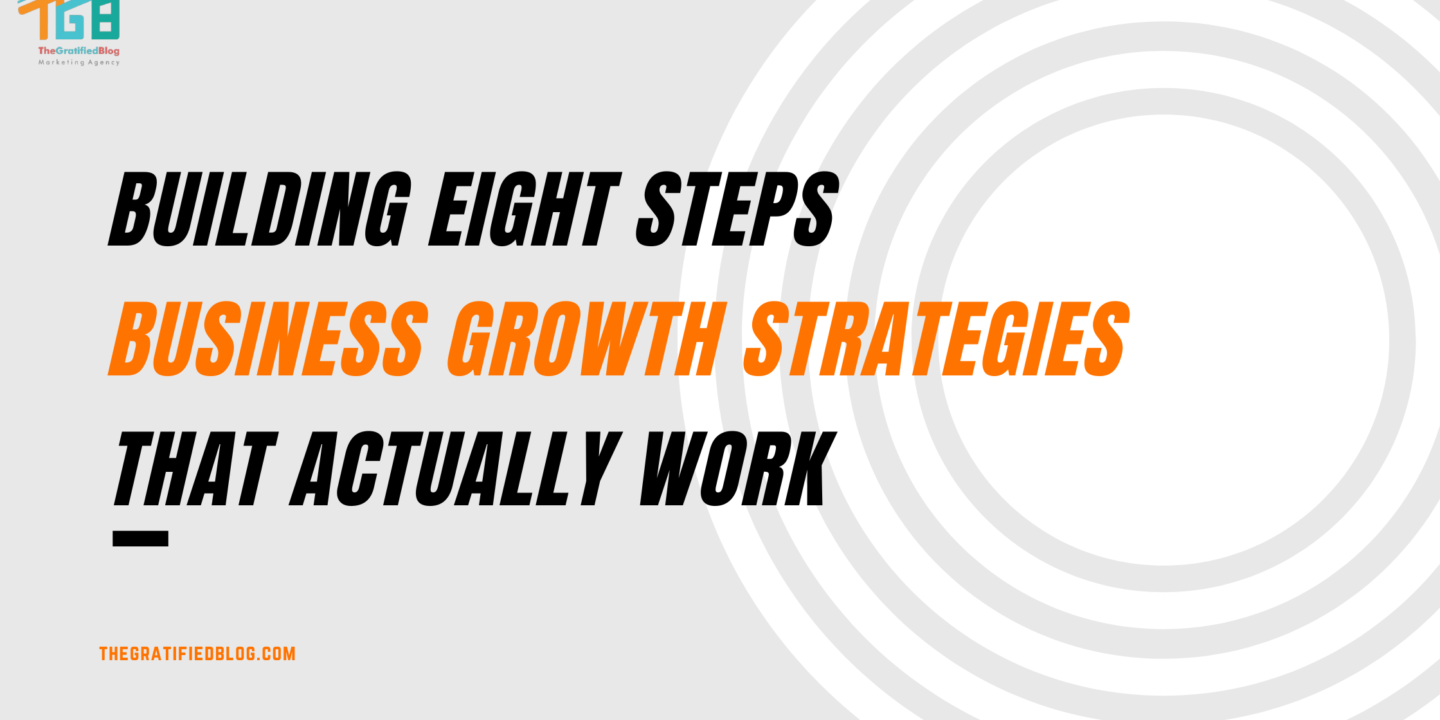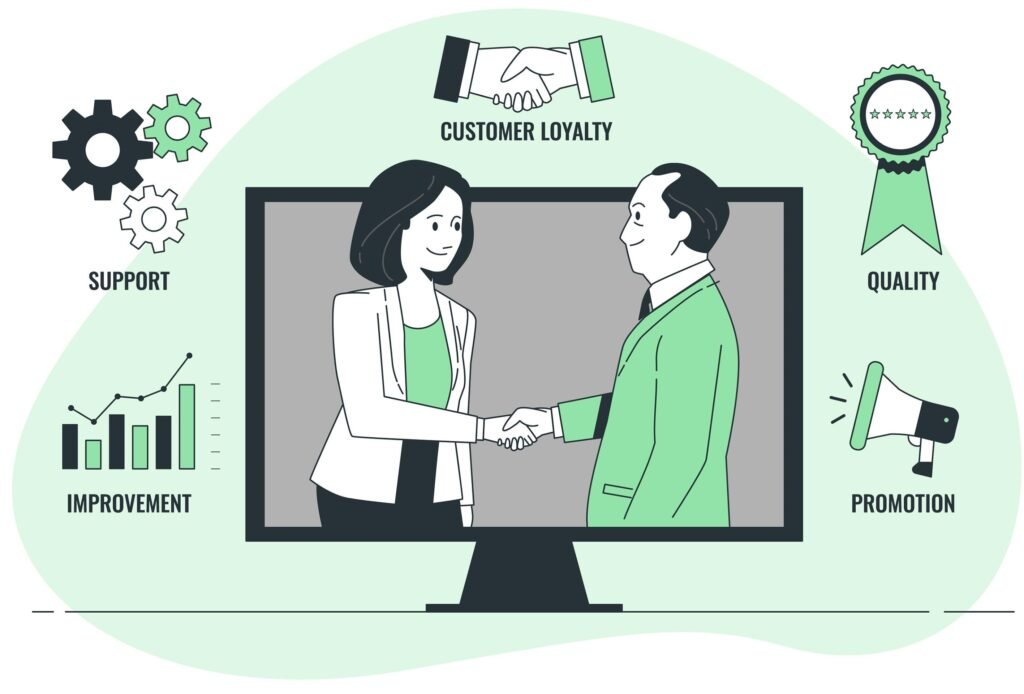
Prepare yourself to discover the keys to success with our captivating blog post on business growth strategies. Delve into the world of unlimited possibilities as we unveil eight powerful strategies that can propel your business to new heights, regardless of the market you operate in.
Whether you’re an ambitious or visionary entrepreneur, this blog post guides you in navigating toward success, achieving exponential growth, and unlocking the doors to unlimited potential. Prepare for an impactful journey marked by transformation filled with valuable insights, actionable steps, and the key to unlocking your business’s potential.

So, let’s get started.
What Is Business Growth?
Business growth entails the process of expanding and strengthening your business while achieving higher levels of profitability. It signifies that your business is evolving and flourishing, driven by its ability to meet its customers’ ever-changing needs and demands effectively.
As your business grows, it demonstrates its capacity to adapt, innovate, and seize opportunities, resulting in increased success and improved financial performance.
Component Of Business Growth Strategy
Many different components go into designing a business growth strategy. Some of them are as follows:
Conduct Market Research
The development process dramatically relies on the crucial role played by market research in a robust business growth strategy. By thoroughly analyzing your industry landscape, competitors, and target customers, you gain valuable insights that inform your strategic decisions and enable you to optimize your approach for maximum impact.
Conducting market research empowers you with compelling information about the preferences, needs, and behaviors of your target audience. Utilizing this information empowers you to customize your products, services, and marketing strategies to resonate effectively with your customers, boosting your chances of success.
To conduct market research effectively, consider employing various practical methods such as surveys, focus groups, industry reports, and analysis tools. These approaches help gather essential data and perspectives, comprehensively understanding market trends, customer preferences, and competitor strategies. Equipped with these insights, you can make well-informed decisions, refine your business growth strategy, and gain a competitive edge in the market.
Set Your Growth Goals
After conducting thorough market research and gaining insights into your target customers and industry, it’s crucial to establish well-defined and attainable growth goals for your business.
These goals should be rooted in the data and knowledge acquired through your market research efforts. By aligning your goals with the information gathered, you ensure your objectives are realistic and relevant to the market dynamics and customer preferences.
For instance, common business growth goals may involve increasing sales revenue by a specific percentage within a defined timeframe or expanding into new markets within a set period. Setting these goals provides clarity and direction, guiding your business toward measurable outcomes and facilitating effective decision-making.
Creating Your Strategy For Execution
This step involves translating your business growth goals into practical steps and action plans. It’s about developing a roadmap that outlines the specific actions, tactics, and techniques you will implement to achieve your desired outcomes.
By incorporating these components into your business growth With a well-thought-out strategy, you can establish a sturdy groundwork for success and optimize your chances of achieving sustainable growth and expansion.
Now that you know the essential components of business growth strategy, let’s look at some key strategies to help you drive success in your business.
Eight Business Growth Strategies
We know that business growth success ultimately comes down to strategy. Here are some key strategies that can help your business in any market:
Market Penetration
Market penetration is a growth strategy that aims to increase sales and expand your business by targeting a more extensive customer base within the same market. This strategy involves implementing innovative marketing tactics, introducing new and unique products or services, and investing in customer experience management systems to drive sales and boost revenue.
However, it’s crucial to note that market penetration may not suit every business. Its effectiveness depends on factors such as your specific business goals, target customer demographics, and the dynamics of your industry.
Expanding into new markets might be a more viable strategy for achieving growth and success in certain situations. It’s important to carefully assess and evaluate your business context before deciding which approach aligns best with your objectives.
Build Partnerships

Establishing strategic partnerships with businesses in your industry or niche is a highly effective growth strategy. These partnerships can take on different forms, encompassing forming strategic alliances, embarking on co-marketing campaigns, entering into joint ventures, or acquiring other businesses.
When you collaborate with the right partners, it opens up a world of opportunities for your business. It enables you to expand your market expand your reach, access new customer segments, and strengthen your brand awareness through mutually beneficial relationships. By utilizing the capabilities and resources of your business and partnering with others, you can expedite your growth trajectory and gain a competitive edge in the market.
Selecting partners that align with your business goals, values, and target audience is essential. Collaborating with like-minded businesses with similar visions can foster synergy, drive innovation, and create long-term value for both parties. Building partnerships is a strategic investment that can significantly contribute to your business’s growth and success.
Market Disruption
Market disruption is introducing new products and services to an existing market. This strategy is often used by startups looking to shake up their status and force competitors to react. Gain a competitive edge in the market.
While there can be risks associated with market disruption, This strategy can take many forms, from leveraging emerging technologies or business models to creating new products or services that change how people think about your niche. The key is to identify trends in your industry early on and capitalize on them before they become mainstream.
For example, How Dollar Shave Club disrupted the razor market, and apps like Uber and Airbnb have disrupted the transportation and hospitality industries.
Product Diversification
Product diversification is a well-established strategy with significant value, particularly in highly competitive industries. By introducing new products or services targeted at different market segments, businesses can unlock untapped revenue, Unleash their potential, and attain a competitive edge over their competitors.
For instance, a notable example of successful product diversification is Semrush, which expanded beyond analytics tools and ventured into content marketing and paid search platforms to cater to a broader customer base.
It’s important to acknowledge that only some diversification strategies will yield the same results for some businesses. To determine the most effective approach, thorough market analysis and understanding of the target audience are crucial. By assessing the market landscape and customer preferences, Companies can decide which products or services are most prominent and likely to succeed, allowing for informed decisions and strategic product diversification.
Adopting New Channels
Embracing new marketing channels is imperative for businesses to thrive in the ever-evolving digital landscape. It entails harnessing the power of social media, search engine optimization (SEO), content marketing, and other technologies to extend your reach, engage a broader audience, and establish a strong brand presence.
Investing in the right strategies and tools is essential to adopt new channels. For instance, incorporating social media marketing into your overall marketing efforts is crucial to connect with younger demographics and remain relevant in their digital world. Additionally, implementing a robust SEO strategy enables you To tap into a more comprehensive array of potential customers within your target market, giving you a competitive edge.
By leveraging these new channels, businesses can tap into fresh opportunities, engage with their audience on multiple platforms, and enhance brand visibility. However, tailoring your approach to your particular business objectives, audience, and industry dynamics is vital to ensure optimal results.
Increase Customer Experience

Elevating the customer experience is paramount to business success, as customers serve as the lifeblood of your organization. It requires a customer-centric approach that places their needs and preferences at the forefront, shaping every aspect of your business operations, from product development to sales processes.
To enhance the customer experience, adopting omnichannel marketing strategies that deliver a seamless and consistent experience across various touchpoints is crucial. This ensures that customers receive a cohesive brand experience, whether interacting with your business through your website, social media, or physical stores.
For instance, implementing personalized content recommendations on your website or providing exclusive perks and rewards to loyal customers can significantly improve overall satisfaction and drive higher conversion rates. Customizing the customer experience according to individual preferences enables businesses to forge deeper connections, foster loyalty, and ultimately drive business growth.
Creating Content For The Audience, Not Search Engines Or Bots
To connect with your online target audience, you must create quality content that truly resonates with them. This means prioritizing the needs and interests of your audience over solely concentrating on keywords or optimization tactics that may need to be more relevant or valuable to your potential customers.
To generate compelling content for your audience, you must thoroughly research their needs and preferences and develop a consistent publishing strategy that you can sustain over time. That might include creating helpful guides, engaging social media content, or video marketing that tells a compelling story.
Be Consistent
To achieve any business success, consistency is most important across all areas of your strategy and operations. Whether focusing on marketing, sales, product development, customer service, or any other aspect of your business, consistency is critical for driving growth and gaining a competitive edge.
To be consistent in your strategy, you must develop robust processes for managing operations and meeting deadlines. You may also need to invest in the right tools (analytics platforms, marketing automation software, CRM systems, etc.) and technologies that allow you to scale quickly as needed.
Conclusion
Remember to stay focused, consistent, and driven, whatever your strategy or business growth is. With the right strategy and tactics, you can achieve great things for your business and reach new heights!
If you have any questions about the above topic, please leave them in the comment section. We will be happy to answer you.
Thanks for reading 🙂
Also read: A Complete Guide To Know What Brand Content Is, and
How To Create A Brand Marketing Strategy?








No Comments